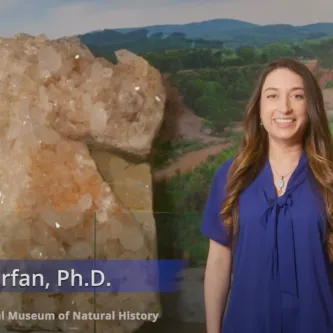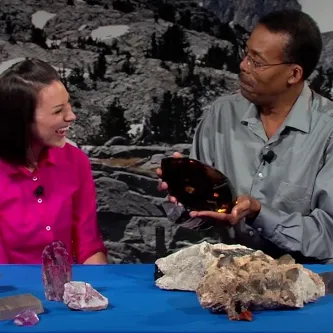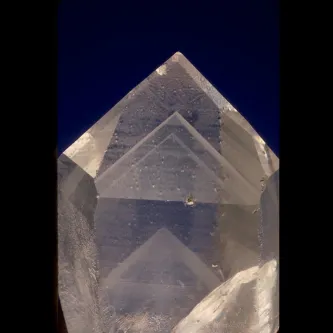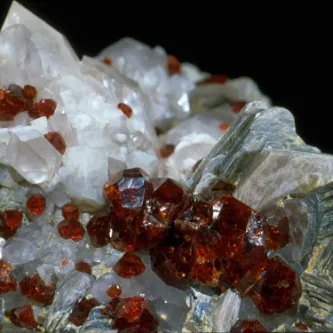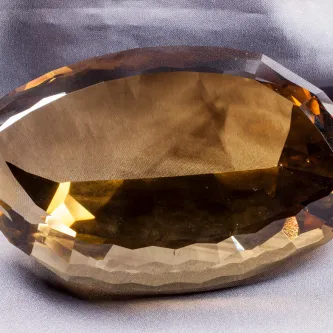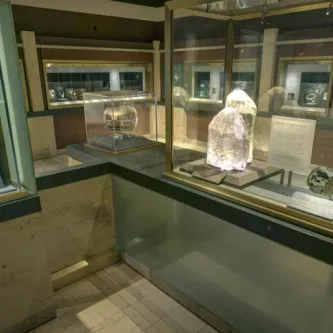Search
Gems and Minerals – Beauties and Building Blocks
What Is a Mineral? What Is a Rock?
Diamonds, graphite, quartz, table salt, and ice are all minerals, some of which you may already know a little about. Granite, marble, and sandstone are examples of rocks — natural materials that are used as building or decorative stone. All are part of the solid earth, but how are rocks different from minerals and gems?
A geologist defines a mineral as a solid formed by natural processes that has a crystalline structure — a unique arrangement of atoms — and a characteristic chemical composition. Minerals are the geological building blocks of the solid earth, because they combine in different ways to make many types of rocks. If you say a rock is like a salad, each mineral would be a different ingredient of that salad. The ingredients can all be separated, but no matter how small you cut those ingredients, they are still carrots, tomatoes and lettuce. For example, granite is made up of the minerals quartz, feldspar, and other minor minerals.
The minerals in every rock help tell the story of how that rock was made. The key factors involved in the formation of many rocks are the chemical elements involved, and the temperatures and pressures they experience when the rock is being formed. Minerals are formed from fluids, for example, when magma (molten rock) begins cooling down and the atoms begin arranging themselves into crystalline structures, or when dissolved atoms precipitate from a water-rich solution (such as the salt that remains after salt water evaporates). Although minerals are not alive, they do grow, but not like living creatures. As trillions of atoms connect in regular, three-dimensional patterns, each crystal starts out small and gets larger as more atoms are added.
Gems & Minerals: Facets vs. Faces
So how are gems different from minerals? As a mineral crystal grows it sometimes develops natural flat sides, or faces, if there is space to grow without interference from other crystals. Crystals may form a variety of different geometric shapes, such as cubes, needles, or prisms. The shape a crystal grows into depends on the crystal’s atomic structure as well as the temperature and pressure under which it forms. Mineral crystals valued for their qualities of color, clarity, beauty, durability, and rarity may be suitable for fashioning into gems ready to be set into jewelry. Gems have facets, which are the sides or edges that have been cut, shaped, and polished by a gem cutter (or lapidarist).
The Hope Diamond
The Smithsonian Institution’s mineral and gem collection consists of approximately 350,000 mineral specimens and 10,000 gems, making it one of the largest of its kind in the world. The collection is used for scientific research, education programs, and public exhibitions. Probably the most famous object in the Smithsonian’s collections, the Hope Diamond is among the most visited museum objects in the world. Each year, millions of people come to the Smithsonian National Museum of Natural History to see this geologic and historic icon.
Why is it so popular? Because it is rare and valuable: Only one out of every several hundred thousand diamonds is blue in color, and the Hope Diamond is the largest deep-blue diamond in the world. It was cut from a rough crystal that was forged more than a billion years ago by the intense heat and pressure found about 100 miles deep in the earth. Smithsonian geologist Jeffrey Post says its creation was an extremely rare event in Earth’s history.
The Hope Diamond has also had some fascinating travels. Brought to France from India in the 17th century, the gem’s recent history includes a stint in the French Crown Jewels, a daring theft, two recuttings, an English King, a wealthy American socialite, a bit of mystery, and a rumored curse or two.
Mineral Research
Studying the nature and behavior of minerals is essential for understanding the physical, chemical, and biological processes that shape our planet. Scientists have identified more than 6,000 different minerals so far and are discovering new ones every year. Smithsonian geologists study minerals to understand the formation and evolution of our planet and the Solar System. In the Museum’s Department of Mineral Sciences, researchers are examining the compositions and structures of minerals to understand a variety of processes, including how minerals control the distribution of chemicals and nutrients in the environment, the evolution of the Earth’s crust and mantle, and the causes of defects and impurities in the coloring of gems and minerals.
Ioan Lascu studies the magnetic properties of minerals such as iron oxides. Magnetic minerals crystallize in rocks and sediments and can act as compasses, recording the direction and intensity of Earth’s magnetic field at the time of their formation. Some magnetic minerals can be made by bacteria, who use these very tiny compasses to efficiently navigate their environment. For examples of Dr. Lascu’s latest research, visit his Google Scholar page.
Gabriela Farfan studies the crystal structure and chemistry of minerals to answer questions about how they form and how they record the environments in which they grew. Her work focuses predominantly on biominerals (minerals formed through biological processes), such as biocarbonates, bioapatites, and biosilicas. For example, she is currently studying how crystal signatures in coral skeletons and mollusk shells correlate with environmental variables and trap the trace element signals that are commonly used in environmental proxies to recreate past environments. She also works on gem science — the science behind minerals used for gems and jewelry — like this study on the Winston Red Diamond. For more examples of Dr. Farfan’s latest research, visit her Google Scholar page.
Michael Wise studies pegmatites, the parts of magma chambers that are the last to crystallize. Pegmatites may contain both valuable ore deposits and large crystals. Michael’s goal is to understand the evolution of granite-pegmatite systems, which includes not only the origin of pegmatites, but also the derivation and evolution of granites that ultimately produce them. To achieve this goal, his field-based research focuses on three broad areas: crystal chemistry and crystal structures of pegmatite minerals, petrology and geochemistry of pegmatites, and the evolution of mineral assemblages and granite-pegmatite systems.
Why All Minerals Aren't Everywhere
Although minerals are found all over the Earth, it is the geologic conditions — rock type, chemical composition of magma, pressure, temperature, and the presence of fluids — that determine which specific group of minerals will be found in a particular geographic region. A mountain range covering a large geographic area and consisting mainly of granite will generally have a different set of minerals compared to a mountain range comprised mostly of limestone or shale.
Some minerals are found in many places on Earth, while others are only locally abundant or extremely rare. Quartz is a common mineral because its ingredients — oxygen and silicon — are two of the main components of Earth’s crust. By comparison, diamonds are much rarer because they are created only under a specific set of geologic conditions. Diamonds are formed when carbon, which is fairly abundant in the Earth’s mantle, is subjected to extremely high pressure and temperature found at about 150 km below Earth's surface. Today we mostly find diamonds where very old continental rock exists, such as southern and central Africa, Siberia, northwestern Canada, India, Brazil, Borneo, Australia, and the U.S. Rocky Mountains, in volcanic rock formations called kimberlites. Gem varieties of the mineral beryl, such as aquamarine (blue beryl), emerald (green beryl), or morganite (pink beryl), are widespread but require very different chemical conditions for their formation, even though they both are commonly associated with a rock called pegmatite. And even though pegmatites are found on every continent, not all of them contain gem beryl.
Metallic mineral resources such as gold, copper, iron, and aluminum, and non-metallic mineral resources like gravel, building stone, sand, gypsum, and salt are invaluable to our everyday life. Today’s technology relies heavily on extremely rare metals such as tantalum, beryllium, and lithium, all of which are extracted from rocks and minerals. Because we use so many minerals as resources to create various aspects of human civilization, knowing where to find certain minerals is extremely important. Knowing where to look begins with a solid understanding of minerals, rocks, and Earth’s geologic history.
This article was updated July 31, 2025.
